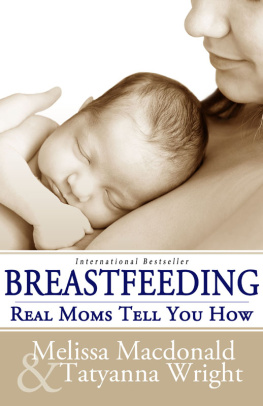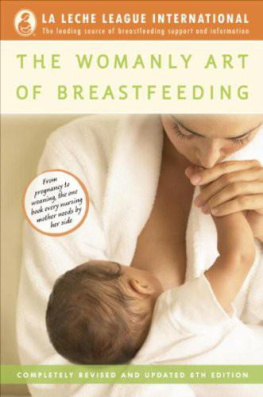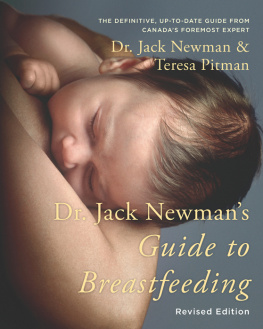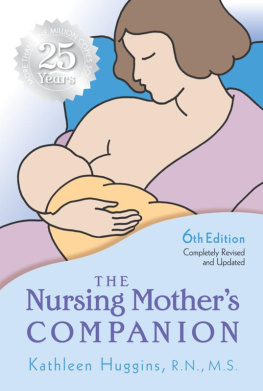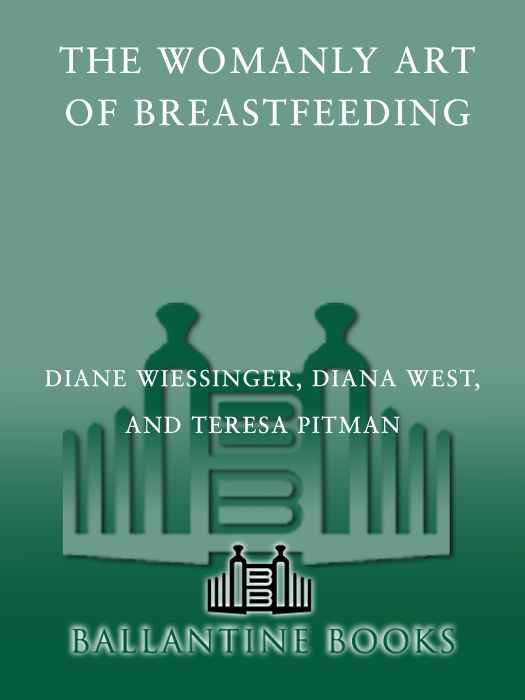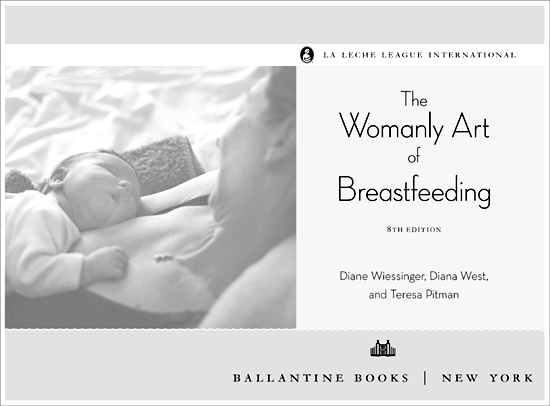This book is dedicated to mothers and babies everywhere.
May you find your own way, with confidence and pride,
as you experience the womanly art of breastfeeding.
Contents
PART I
ONE
TWO
THREE
FOUR
PART II
FIVE
SIX
SEVEN
EIGHT
NINE
TEN
ELEVEN
PART III
TWELVE
THIRTEEN
FOURTEEN
FIFTEEN
SIXTEEN
SEVENTEEN
EIGHTEEN
PART IV
NINETEEN
TWENTY
Welcome!
Before there was The Womanly Art of Breastfeeding, there was what Ive always thought of as The Story of Breastfeeding. That Story wasnt written down; it was the breastfeeding wisdom passed down from one generation to the next, mother to mother. Unexpectedly, beginning in the first part of the twentieth century in the most developed parts of the world, the transfer of The Story practically ceased. But not entirely. The remembrance of The Story of Breastfeeding nourished the writing of the first edition of The Womanly Art, published in 1958, cradling it and sustaining its promise.
What never disappeared was the instinctive desire held by many mothers who longed to breastfeed their babies despite the highly touted advances of bottle-feeding (only later correctly labeled artificial infant feeding). For many of these hopeful mothers, the desire to breastfeed was thwarted early on due to misinformation or the plain lack of information.
I was one of those mothers with my Elizabeth, my first baby. Advised by the doctor that I didnt have enough milk, I began supplementing with formula. It was the beginning of the end of breastfeeding for us at three months, a regret I carry to this day.
A move to Franklin Park, Illinois, brought our family in touch with Dr. Gregory White, who was alternately referred to as totally out of step with the times or a prophetic maverick. My husband, Chuck, and I were delighted to learn he believed in old-fashioned natural childbirth and breastfeeding. (Early in our parenting career, Chuck simply went along with my offbeat ideas, but later he became a strong advocate of them.)
With the birth of our second child, Timothy, in 1952 and with Dr. Whites steady guidance, we were on the right track. A protg of Dr. Herbert Ratner, an early advocate of the wisdom of nature, Dr. White gave me the best mothering advice I ever received: A babys wants are a babys needs. Gone were the confusion and worries about spoiling my baby, holding him too much or too little, following the clock, or nursing on demand. It was wonderful, blessed freedom!
Around the same time, I discovered other young mothers who were also breastfeeding their babies, an underground of anti-establishment mothering, picking their babies up rather than letting them cry and taking them with them when going out. One of these mothers lived around the corner from me, Betty Wagner; her family was somewhat older than mine.
As we walked our babies on summer evenings, Betty shared her breastfeeding experience, little tips that made nursing the baby and caring for a growing family less stressful, more enjoyable. Various strands of The Story were coming together for mecaring, like-minded women companions, a supportive family, knowledgeable medical professionals.
In 1956, the most memorable instance of the revitalization of The Story of Breastfeeding came about when seven women in the Franklin Park area, all by then experienced breastfeeding mothers, chose the name La Leche League and committed themselves to reaching out to help other mothers who also longed to breastfeed their babies. The core group, hereafter known as the seven founders of La Leche League, consisted of Mary Ann Cahill, Edwina Froehlich, Mary Ann Kerwin, Viola Lennon, Marian Tompson, Betty Wagner, and Mary White. Both Dr. White and Dr. Ratner remained lifelong champions of breastfeeding and La Leche League, which spread rapidly, like a smoldering fire newly reignited.
And so the final element fell into place for the continuation of The Story of Breastfeeding. A forum and process were put in place for mothers to come together, observe a loving and natural way of mothering, exchange information, and find support and companionship.
This new edition of The Womanly Art of Breastfeeding, the eighth, furthers this effort, opening new worlds of breastfeeding information, from pertinent findings from the scientific literature to the homey and highly prized experiences of ordinary mothers and babies. A totally new rewrite, it is a tribute to its three writers. Yet in the background, arrayed like a Greek chorus, stand the many mothers who have come before us.
Dear Reader, turn the pages, begin the story, and discover the beauty and power of breastfeeding. Step into history. There is a place for you in what will always be your own highly personal experience and enduring memories but also an act of great consequence to you, your child, and your family. To all of society. To the world. Thank you!
Mary Ann Cahill, La Leche League International co-founder
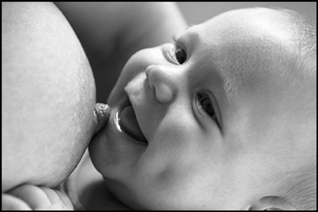
Veer Incorporated
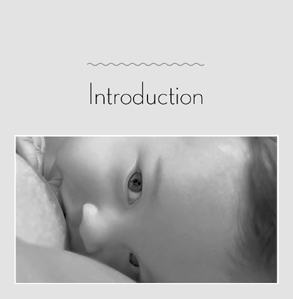
David Stark Photography
Welcome to the newest edition of The Womanly Art of Breastfeeding! This is a book for you, wherever you are in your mothering journey. Its a book about developing a breastfeeding relationship with your baby, with strategies that help combine breastfeeding with your already busy life, and ideas for meeting any challenges along the way. Theres some science, for sure, but we hope to bring to life the art part, the fun part, the way you and your baby figure out your own dance and make this work for you.
Does our title sound old-fashioned? Thats because its been around for more than half a century, dating back to 1956, when almost all TV shows were black and white and many countries breastfeeding rates were at an all-time low. The Womanly Art of Breastfeeding was the first book about breastfeeding for mothers that was written by mothersseven of them, in fact.
These mothers didnt start out to write a book. They were enjoying breastfeeding their babiesmany of them had bottle-fed earlier children and breastfed later childrenand they had all figured out, as mothers always have, that breastfeeding is much easier when we talk about it with friends. So they began holding monthly get-togethers in their homes for other women interested in (shhh) breastfeeding. Because the very word was shocking in those days, they chose a code name: La Leche (lah LAY-chaySpanish for the milk) League, after a shrine in St. Augustine, Florida, Nuestra Seora de la Leche y Buen Parto (Our Lady of the Milk and Good Birth).
That first La Leche League Group quickly became multiple groups. Questions from local mothers became questions from across the country. By 1958, to keep up with the flood, the women had written a simple overview of breastfeeding basics. They made copies, their children helped collate the pages, and the first Womanly Art of Breastfeeding


